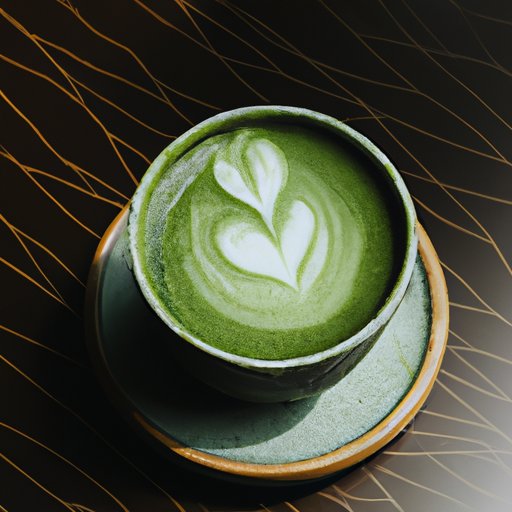Introduction
Matcha has been increasing in popularity during recent years. As a trendy coffee shop option, matcha has converted many coffee enthusiasts into choosy matcha latte supporters. While enjoying it at a coffee shop may seem like the best option, making a matcha latte at home can be just as fun and flavorful. This article will provide a step-by-step guide to making a delicious, healthy cup of matcha latte at home. It’s perfect for beginners who may be curious about the taste and benefits of matcha.
Recipe-based article
To make the perfect cup of matcha latte, it is essential to have the proper ingredients. You will need matcha powder (preferably high-quality), milk, and a sweetener of your choice (honey, agave, maple syrup, or white sugar).
Begin by adding two teaspoons of matcha powder to a small bowl. Using a sifter or a fine-mesh strainer, sift the powder, this will serve to prevent any potential lumps in your drink. Adding to the sifter and gently agitating will help move the matcha through the mesh.
Once sifted, add 2 ounces of hot water (just under boiling point), and whisk vigorously with a fork or a chasen (specialized bamboo whisk). The matcha should become frothy, creamy and vibrant green. Whisking helps distribute the powder, texture and boosts flavors, aiding in the overall taste.
While whisking, heat and froth milk (or milk alternative) until it’s noticeably warm and frothy. You can use any milk type, but oat, almond, coconut, and soy tend to be the most popular.
Finally, combine the frothed milk and matcha mixture, and add sweetener to taste. For healthier options, use honey, agave, pure maple syrup, or even natural non-sugar options like stevia or monk fruit.
Health benefits of matcha
Matcha contains natural antioxidants that provide plenty of health benefits. Matcha leaves are known to have higher amounts of antioxidant polyphenols, catechins and the amino acid L-Theanine than most other teas. Catechin concentration in matcha has been found to be approximately 137 times greater than the amount of catechins in traditional green teas.
L-Theanine, in particular, is known to help keep us calm and focused. This assists the matcha drinker in feeling relaxed and alert simultaneously, without inducing the jittery feeling often associated with coffee. Together, matcha’s natural blend can help improve metabolism, maintain detoxification and boost energy. Matcha is a good replacement for coffee or energy drinks.
Variations on classic recipe
Adapting a matcha latte is easy and can make your drink unique. Here are some variations.
Flavorings
Matcha substance has a distinct and comforting earthy green tea flavor. Mixing flavors, such as vanilla or caramel, can add taste and depth to the drink without obscuring the matcha taste entirely. The easiest method is to use syrups- a standard coffee shop procedure, but using homemade syrup can make your drink a unique culinary experience.
Milk Alternatives
For a vegan-friendly choice or simply to explore other textures, non-dairy milk types can be used to make hot matcha drinks. Oat milk is an excellent choice to add creaminess. Soy and almond both provide a unique taste that can complement the matcha taste.
Culinary uses of matcha
Matcha is a versatile ingredient, making it an ideal option for culinary recipes. Here are a few ways to incorporate matcha into different types of cuisine.
Baking
Matcha baked goods are gaining immense popularity as people start to discover the unique flavor profile. Matcha cupcakes, shortbreads, cookie bars and cakes tend to be at the top of the list. The natural green color adds a distinct quality and flair to the final product, making it a great item for serving at a party or a gift.
Desserts
Cheesecake, ice cream, and even mousse can have matcha additives for a personal taste adventure. Making a matcha shake can also spruce up the usual protein shakes or give something new to snack on.
Savory dishes
Matcha is a fitting ingredient for various savory dishes. Many people are adding a teaspoon of this substance into their ramen broth or using it to flavor roasted vegetables. Matcha-seared tuna and stir-fried rice are also popular choices.
Matcha and tea culture
Matcha is a cultural symbol of Japanese tea ceremonies that have been around since the 12th century. These traditions and ceremonies center around the beverage, preparing it requires focusing on each movement and process. It involves slow stirring and a calming atmosphere that allows the drinker to concentrate on the moment.
Making a matcha latte at home provides a more relaxed way to experience matcha culture. Taking time and effort to whisk and brew a cup are calming and therapeutic. This drink has become synonymous with Japanese tea culture and can provide moments of calm introspection during a busy day.
Conclusion
Matcha lattes can be the perfect beverage to whip up in the comfort of your home. Not only is it easy to make, and unique, but the health benefits make it a superior alternative to other beverages. In addition to the classic recipe, matcha can be utilized in various other culinary recipes beyond bakeries and desserts. It’s a well-rounded substance that has a significant cultural influence. It can be enjoyed as an at-home ritual, offering moments of peaceful clarity during a busy day.
